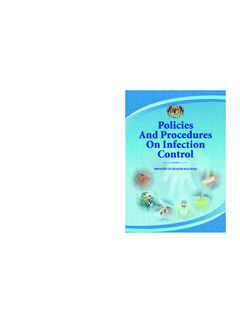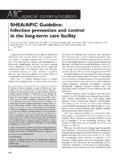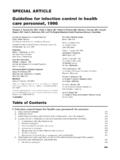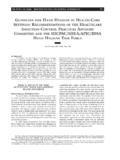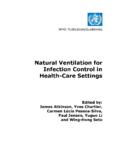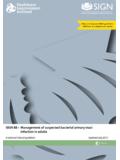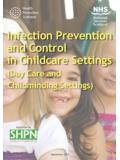Transcription of WHO/CDS/CSR/APH/2000.3 WHO Infection Control …
1 WHO/CDS/CSR/ Infection Control Guidelines for TransmissibleSpongiform EncephalopathiesReport of a WHO consultationGeneva, Switzerland, 23-26 March 1999 World Health OrganizationCommunicable Disease Surveillance and ControlThis document has been downloaded from the WHO/EMC Web site. Theoriginal cover pages and lists of participants are not included. for more information. World Health OrganizationThis document is not a formal publication of the World Health Organization(WHO), and all rights are reserved by the Organization. The document may,however, be freely reviewed, abstracted, reproduced and translated, in part orin whole, but not for sale nor for use in conjunction with commercial views expressed in documents by named authors are solely theresponsibility of those authors. The mention of specific companies or specificmanufacturers' products does no imply that they are endorsed orrecommended by the World Health Organization in preference to others of asimilar nature that are not 1 SECTION CONSIDERATIONS.
2 SPONGIFORM ENCEPHALOPATHIES IN HUMANS AND IN OF HUMAN TRANSMISSIBLE SPONGIFORM RISK IN HEALTHCARE 3 SECTION 3. PATIENT CARE .. OF PATIENTS IN THE HOME AND HEALTHCARE OF SURGICAL AND 9 SECTION INJURY .. 10 SECTION SAFETY IN THE HEALTHCARE CLINICAL DIAGNOSTIC OF SPECIMENS BY 13 SECTION PROCEDURES .. OF OF WORK OF WASTES AND WASTE-CONTAMINATED PROTECTION DURING DECONTAMINATION RISK 16 SECTION DISPOSAL .. 16 SECTION DEATH .. FOR HANDLING OF THE DECEASED MORTEM AND INTERNATIONAL TRANSPORT OF AND AND DONATION FOR TEACHING 21 ANNEX ILIST OF 23 ANNEX IILIST OF IIIDECONTAMINATION METHODS FOR TRANSMISSIBLE 29 ANNEX IVMANAGEMENT OF HEALTHY AT RISK INDIVIDUALS .. 33 ANNEX VMANAGEMENT OF INDIVIDUALS WITH CONFIRMED OR SUSPECTEDVARIANT CREUTZFELDT-JAKOB DISEASE.
3 35 WHO/CDS/CSR/ Infection Control Guidelines for Transmissible Spongiform Encephalopathies1 Section spongiform encephalopathies (TSEs), also known as prion diseases,are fatal degenerative brain diseases that occur in humans and certain animal are characterized by microscopic vacuoles and the deposition of amyloid (prion)protein in the grey matter of the brain. All forms of TSE are following guideline on the prevention of iatrogenic and nosocomial exposure toTSE agents was prepared following the WHO Consultation on Caring for Patients andHospital Infection Control in Relation to Human Transmissible SpongiformEncephalopathies, held in Geneva from 24 to 26 March 1999. The meeting was chairedby Dr Paul Brown. Dr Martin Zeidler and Dr Maurizio Pocchiari kindly agreed to beRapporteurs. The full list of participants is given in Annex I.
4 Presentations made at theConsultation are listed in Annex document provides guidance upon which Infection Control practitioners,healthcare practitioners, medical officers of health, and those involved in the care ofpersons suffering from TSE can base their care and Infection Control practices, to preventevents which are either extremely rare ( transmission of TSE through a surgicalprocedure) or hypothetical ( transmission of TSE to a healthcare worker or familymember). Throughout the document there is specific and assumed reference to countryor region-specific guidelines for matters which lie within the legal jurisdiction of thatcountry or region, International Air Transport Association (IATA) regulations fortransportation of hazardous goods, or bio-safety containment levels for should be familiar with such requirements for their own country or on which the consultants could not agree, or where the consultantsdid not feel there was sufficient expertise to render an opinion, have been consultation recognized that its recommendations to ensure maximum safety to care-givers and the environment may under some circumstances be regarded as , they urged personnel involved with TSE patients or tissues to endeavour tocomply as far as possible.
5 There is no reason for a patient with a TSE to be denied anyprocedure, as any associated risks should be reduced to negligible levels by following therecommendations in this 2. GENERAL Spongiform Encephalopathies in humans and in animalsHuman TSEs occur in sporadic, familial, and acquired forms. The most commonform, sporadic Creutzfeldt-Jakob disease (CJD), has a worldwide death rate of about1 case per million people each year, and typically affects people between 55 and 75 yearsof age. The disease usually begins with a progressive mental deterioration that soonbecomes associated with progressive unsteadiness and clumsiness, visual deterioration,muscle twitching (myoclonus), a variety of other neurological symptoms and signs, andis often associated with a characteristic periodic electroencephalogram. The patient isusually mute and immobile in the terminal stages and in most cases, death occurs withina few months of onset of symptoms.
6 TSEs are invariably fatal and there is no proventreatment or Infection Control Guidelines for Transmissible Spongiform EncephalopathiesTable 1 Human TSEsHuman TSEF irst ReportedCreutzfeldt-Jakob Disease (CJD):1 Sporadic (85-90%) Familial (5-10%) Iatrogenic (<5%) Variant (vCJD)1921192419741996 Gerstmann-Str ussler-Scheinker Syndrome (GSS)1936 Kuru1957 Fatal Insomnia Familial Sporadic19861999 Similar neurodegenerative diseases also occur naturally in some animal species(scrapie in sheep and goats, chronic wasting disease in deer and elk), or as a result ofexposure of susceptible species to infected animal tissues (transmissible minkencephalopathy, bovine spongiform encephalopathy, and spongiform encephalopathy indomestic cats and a variety of captive zoo animals).TSE agents exhibit an unusual resistance to conventional chemical and physicaldecontamination methods.
7 They are not adequately inactivated by most commondisinfectants, or by most tissue fixatives, and some infectivity may persist under standardhospital or healthcare facility autoclaving conditions ( 121 C for 15 minutes). Theyare also extremely resistant to high doses of ionizing and ultra-violet irradiation and someresidual activity has been shown to survive for long periods in the environment. Theunconventional nature of these agents, together with the appearance in the UnitedKingdom, Republic of Ireland and France of a new variant of CJD (vCJD) since the mid-1990s, has stimulated interest in an updated guidance on safe practices for patient careand Infection of Human Transmissible Spongiform EncephalopathiesThe February 1998 Report of a WHO Consultation the Global Surveillance,Diagnosis and Therapy of Human Transmissible Spongiform Encephalopathies2,3provides a guideline for diagnostic criteria of human TSEs.
8 Readers should be aware ofefforts to revise diagnostic criteria for CJD and vCJD due to the introduction of newdiagnostic tests and intense surveillance efforts. Surveillance case definitions (whichmay not be the same as diagnostic criteria) for both forms of the disease may also besubject to transmissionTSEs are not known to spread by contact from person to person, but transmissioncan occur during invasive medical interventions. Exposure to infectious material throughthe use of human cadaveric-derived pituitary hormones, dural and cornea homografts,and contaminated neurosurgical instruments has caused human TSEs. The Report of a 1 Percentages vary somewhat from country to All cited WHO reports and consultations are available at the WHO Web WHO Consultation on Global Surveillance, Diagnosis and Therapy of Human Encephalopathies.
9 WHO/EMC/ Geneva, 9-11 February Infection Control Guidelines for Transmissible Spongiform Encephalopathies3 WHO Consultation on Medicinal and other Products in Relation to Human and AnimalTransmissible Spongiform Encephalopathies4 can be consulted for more information andguidance on these risk in healthcare environmentsWhen considering measures to prevent the transmission of TSE from patients toother individuals (patients, healthcare workers, or other care providers), it is important tounderstand the basis for stipulating different categories of risk. Risk is dependent uponthree considerations:- the probability that an individual has or will develop TSE (see Section );- the level of infectivity in tissues or fluids of these individuals (Section );- the nature or route of the exposure to these tissues (Section ).
10 From these considerations it is possible to make decisions about whether anyspecial precautions are needed. Specific TSE decontamination procedures are describedin Section 6. If TSE decontamination is required, the question remains as to howstringent it should be. The specific recommendations are described in sections devoted toPatient Care (Section 3), Occupational Injury (Section 4), Laboratory Investigations(Section 5) and Management After Death (Section 8). Identification of persons for whom special precautions applyPersons with confirmed or suspected TSEs are the highest risk patients. They mustbe managed using specific precautions which will be described in this and subsequentsections. All precautions recommended in the body of this document apply to the care ofconfirmed or suspect cases of TSE, or the handling of tissues from such patients, andunless otherwise noted, no distinction will be made between confirmed and suspect cases.










